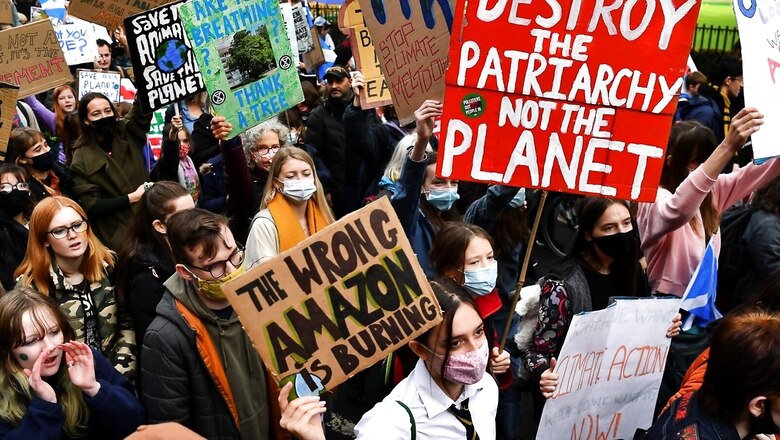
views
The global climate crisis has been the talking point at various regional and global platforms across countries. As the world embarks on this pivotal “decade of action” for climate change, there is a need to strengthen collective efforts to address the crisis by reiterating a principle-based approach for global action. The 26th Conference of Parties (COP26) to the United Nations Framework Convention on Climate Change (UNFCCC) offers a ripe opportunity for the world to assess the progress made so far and calibrate a well-thought-out, long-term strategy for the future course of climate action.
The scientific evidence of the gravity of the climate crisis is clear, as highlighted in the 6th Assessment Report (AR6) of the Intergovernmental Panel on Climate Change (IPCC). The current situation is a “code red” for humanity, and presents structural challenges in the environmental and socioeconomic rubric of all nations. This is further corroborated by general observation, in the form of increasing frequency and intensity of extreme climatic conditions and weather events across the world, such as cyclones, floods, prolonged droughts, heatwaves and other climate-induced disasters. According to a report by the World Meteorological Organisation, on average, one weather or climate-related disaster has occurred every day over the past 50 years, causing daily losses amounting to US$202 million.
The scientific community is now urging governments to make all possible efforts to cut the global emissions to half by 2030 and to aim for global net-zero by 2050. This is no longer a matter of ambitious targets, but one of survival. Given the global footprint of the climate crisis, it is the responsibility of the collective and representative platforms of the world to outline guiding principles and long-term strategies to shape the future of climate action. In this context, the COP26 is a platform where the world as a collective can shape its climate-action strategy going forward and learn, un-learn and modify the same based on current imperatives.
The first step in this direction is to acknowledge the shortcomings in the efforts undertaken so far in terms of mitigating the impacts of climate change. The overall approach has largely followed the “polluter’s pay” principle, with attempts being made to ascribe responsibility to the stakeholders responsible for causing the crisis in the first place and having them proportionately contribute to financing the solutions. In the climate scenario, this approach has been termed as “common but differentiated responsibility” and is premised on the principle of assigning responsibility to various nations in a way that is commensurate to their contribution to fuelling the climate crisis, towards the shared goal of a better future for the planet. One area where this principle has been rigorously adopted is in mobilising finance. As part of the Paris Agreement (2015), developed countries were asked to pledge US$100 billion by 2020. However, achieving these numbers has been a challenge, which, in turn, has slowed down climate action in developing and least developing countries (LDCs), particularly in small island developing states (SIDS), which are both extremely vulnerable to climate change and economically precarious.
Another layer of complexity that creates a bottleneck in effective all-round climate action is the way in which the problem is perceived and the solutions formulated. Climate change, at its core, is a global systems problem, not an isolated issue that can be resolved through in-silos thinking, planning, and policy action. At the same time, the causes and effects of climate change are geographically, socially and demographically distributed, and are known to disproportionately impact the poor and vulnerable. Thus, given the inequity in how climate change impacts various regions and communities, the approach to formulating a solution requires local planning and implementation, in a decentralised and bottom-up manner. This does not imply that global platforms should be delinked from local actions. Instead, it is the role of global forums such as COP26 to amplify, scale-up and ensure cost-effectiveness of localised, community-centric solutions to climate change. Furthermore, while global platforms have voiced the need for ensuring “climate justice” and equitable climate action, a concrete framework of action towards a “just transition” remains largely missing.
The COP26 offers a now-or-never opportunity for nations, policymakers, and citizens to adopt value-based long-term strategies for facilitating a fair, just, effective, equitable and people-centric climate action.
First, the world must acknowledge the complicated systems, the nature of the climate crisis, and the need to deal with it in a united, collective manner. This essentially implies reinvigorating the efforts to institutionalise the principle of common but differentiated responsibility in climate action, both in letter and in spirit. Countries should adopt an equity and justice-based approach to their domestic climate efforts: while at the global stage, policymakers must push for more stringent action by the developed nations and countries of the North, the same actions must also be implemented by other countries in their national climate efforts. To ensure climate justice, it must be ensured that precarious and vulnerable communities do not face the brunt of the historical actions of comparatively well-off segments of the society or the economy. Additionally, effectively communicating and demonstrating efforts taken in this direction by different nations will become instruments for driving the world towards a more ‘just’ climate action.
Second, nations should acknowledge the science-based driving factors behind the crisis and respect the evidence-based policymaking approach. There should be transparency in acknowledging the failures or successes of all countries and responsibly communicating the lessons to the world. The official representations of countries should avoid the temptation to cover up their failures to maintain their position as global leaders of climate action or to play the victim-card to lobby for higher investment inflows domestically. This can enable a healthy environment of dialogues, discussions and knowledge-sharing amongst different countries. The COP26 can become a champion of furthering such a discourse by engaging the global scientific community to independently weigh in on any country’s climate actions, climate-induced disasters, mitigation and adaptation efforts, etc. Such insight should have clear objectives and be a science-based assessment for the global good, without hindering any nation’s independent jurisdiction or autonomy. This can be done in a collaborative manner, in conjunction with the domestic scientific and civil society networks of the respective countries.
Third, decentralised and localised planning and implementation must be acknowledged and incorporated as a strategy in the global fight against climate change. Necessary institutional arrangements can be made in the global architecture of climate actions at the COP26 to impart more significance to local, community-driven solutions to climate mitigation and adaptation. This also connects with the social aspect of climate change, with resilience-building of vulnerable communities being a key pillar. In this context, it is best to enshrine community-based solution planning and implementation as a long-term strategy to address climate change.
Fourth, the global discourse needs to devote substantial consideration to climate change adaptation and building the resilience of vulnerable segments of the society, economy and ecology. There is a need to chalk out sector-wise, country-specific strategies to adapt to adverse impacts of climate change, anticipating natural physical risks and charting out a concrete plan of action for sectors to be resilient in the wake of such risks. The Covid-19 pandemic has reiterated the need to be future-ready and to stay one step ahead in risk-assessment and disaster-management. The urgency with which countries rallied around the goal of becoming more resilient in response to the Covid-19 pandemic should be sought in the climate-action space as well.
Finally, for the successful execution of long-term strategies, policies, practices and ground-level climate action, a critical element is mobilising finance for technology uptake, technology transfer, and climate actions towards mitigation and adaptation. The financing system for global climate actions must acknowledge the inherent inequality in the adverse impacts faced by different nations and communities, due to the unsustainable economic actions of the comparatively richer nations. The imperative, therefore, is to mobilise global finance at an adequate scale and redistribute it in an effective, equitable and just manner. A low-hanging fruit that can effectively ensure a system to check the social, environmental and economic fairness of any proposed economic activity is a “Sustainable Finance Taxonomy.” Taxonomies are at various stages of development and implementation in many countries and regional blocs, such as the European Union, South Africa, China, Malaysia, and India. Such market-based frameworks can provide the yardstick by which to measure the sustainability of mitigation or adaptation methods, while giving due importance to qualitative metrics on social welfare and just transition.
This five-pronged long-term strategy can be a way forward for the global community at the COP26. The idea is to introspect, acknowledge, institutionalise, internalise and develop implementation, monitoring and feedback mechanisms by countries and the world as a collective, to undertake climate actions that are more sustainable, equitable, and effective.
This article was first published on ORF.
The author is Associate Fellow and Lead, Climate Change and Energy at the Centre for New Economic Diplomacy. The views expressed in this article are those of the author and do not represent the stand of this publication.
Read all the Latest Opinions here




















Comments
0 comment